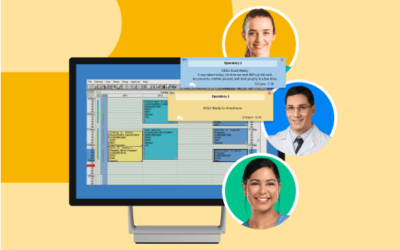
The way teams communicate throughout a dental practice has undergone a significant transformation. Traditionally, dental offices relied heavily on paper-based systems for internal communication. This included paper routing slips, direct conversations, and even a phone call to convey messages within the office. These methods, time-honored as they were, presented a set of challenges that often impeded the smooth operation of a dental practice.
Traditional Communication Methods
The use of paper routing slips, for instance, was a staple in many offices. It involved physical slips of paper to relay information about patient appointments, treatment plans, and follow-ups. While straightforward, this method was fraught with inefficiencies. The risk of misplacing slips, the time spent handwriting notes, and the potential for misinterpretation of handwritten information were common issues. Moreover, this approach lacked the speed required in a fast-moving dental office environment where timely communication matters.
Similarly, relying on face-to-face conversations and phone calls for internal communication had its drawbacks. Real-time verbal communication systems required both parties to be available simultaneously, which was not always feasible in a busy dental practice. Additionally, such conversations, especially those occurring in shared spaces, lacked privacy, which is crucial when discussing patient information.
Digital Tools: A New Era for Dental Office Communication
Recognizing these challenges, dental offices began to explore digital alternatives. The emergence of digital communication tools offered a solution that promised greater efficiency, improved accuracy, and enhanced privacy. Unlike traditional methods, digital tools allowed for instantaneous messaging, easy retrieval of past communications, and a streamlined way to manage patient information.
Among these digital solutions, several general communication tools gained popularity across various industries, including dental practices. Tools like Slack, Google Chat, and Microsoft Teams offered features such as instant messaging, file sharing, and collaboration spaces, which were attractive for their versatility and ease of use. These platforms enabled team members to send quick messages, share documents, and collaborate on patient cases without the need for physical documents or waiting for face-to-face interactions.
The Rise of Specialized Dental Communication Software
Alongside these general tools, there emerged a category of software specifically designed for dental practices. These specialized tools were tailored to address the unique needs of dental offices, offering features that integrated seamlessly with dental practice management software (PMS). This integration was a game-changer, allowing for real-time updates to patient records, automated appointment reminders, and streamlined team communication that linked directly with patient data.
One such example in this category is dental office software that provides a comprehensive communication solution while ensuring compliance with healthcare regulations like HIPAA. These tools are specifically designed to cater to the nuanced needs of dental practices, ensuring patient information is handled securely and efficiently.
Analyzing Specific Communication Tools for Dental Practices
As we mentioned, tools like Slack, Microsoft Teams, and Google Workspace can be popular choices across various types of businesses. But while these general workplace communication tools are feature-rich, they come with inherent limitations and capacity when applied to the specific needs of dental practices. They also have loads of features that may not make sense for a dental office, such as video conferencing for remote work (although, telemedicine is making its way to dentistry). These features can make it harder to find the collaboration tools your team needs, making it less efficient. One significant privacy concern is HIPAA compliance. Dental practices constantly handle sensitive patient information, and maintaining confidentiality and security is not just a preference but a legal requirement. Tools like Slack and Microsoft Teams are not specifically designed with the healthcare sector in mind, and thus, extra steps and configurations are needed to ensure they meet HIPAA standards. This requirement can pose a challenge, especially for a small business with limited IT resources.
Addressing these specific needs, specialized dental office software emerges as a more tailored solution. They integrate directly with popular PMS tools, such as Dentrix, Eaglesoft, and Open Dental allowing for real-time updates and seamless synchronization of patient data. This integration is key for maintaining an efficient workflow where patient information is readily accessible and securely managed.
These specialized tools also offer discreet channels for effective communication, essential in a healthcare setting where privacy is a requirement. For instance, a dental assistant can discreetly inform the front office about a change in a patient’s treatment plan or update patient records without leaving the operatory. This capability not only enhances efficiency but also maintains the confidentiality of patient information.
Case Study: Efficiency in Action
Consider a scenario where a patient’s medical history needs to be reviewed before a procedure. In a traditional setting, this might involve physically retrieving files or verbally communicating sensitive information. However, with specialized dental office software, this information can be accessed instantly and securely, directly from the dental chair. Such efficiency not only saves time but also reduces the risk of errors and breaches in patient confidentiality.
YAPI: An Example of Specialized Software
Within this category of specialized software, YAPI stands out as a solution that addresses the unique business communication needs of dental practices. While maintaining a focus on HIPAA compliance and efficient workflow integration, YAPI provides a platform for real-time, discreet communication and patient data management. It exemplifies the kind of team communication tool that aligns well with the daily operations of a dental practice, offering features that go beyond the capabilities of general employee communication tools.
The Case for Specialized Dental Communication Tools
Let’s dive deeper into the specialized dental tools that stand out for their precise alignment with the unique needs of dental practices. These tools offer a suite of functionalities specifically designed to address the nuances of dental operations, setting them apart from general communication software like Microsoft Office or Google Hangout.
HIPAA Compliance and Secure Data Management
A critical aspect where specialized tools excel is in their adherence to HIPAA regulations. Unlike general tools, they are built with patient privacy and data security as a core component. This means that every feature, from messaging to file sharing, complies with stringent standards for protecting patient information.
For example, when it comes to storing and deleting records, specialized tools ensure that data is handled in a way that aligns with HIPAA’s requirements. They implement secure data storage mechanisms and provide clear protocols for the deletion of sensitive information, ensuring that patient data is not inadvertently exposed or retained beyond necessary periods. This level of attention to data security is often lacking in general communication tools, which might not offer the same rigor in data handling and deletion protocols.
User-Level Access Control
Another advantage of specialized dental communication tools is their ability to provide user-level access control. This feature ensures that staff members access only the information necessary for their specific roles. For instance, a dental hygienist may need access to a patient’s medical history but not their billing information. Specialized tools can restrict access based on user roles, enhancing data security and minimizing the risk of unauthorized access to sensitive information.
Patient Communication with HIPAA in Mind
Advanced features like patient communication are also crafted with HIPAA considerations at the forefront. Specialized tools offer secure channels for communicating with patients, whether it’s for appointment reminders, treatment follow-ups, or sharing health information. These communications are encrypted and designed to safeguard patient confidentiality, a critical requirement in healthcare settings.
Shortcomings of General Communication Software
In contrast, general communication tools often fall short in these areas. While they may offer robust features for messaging and collaboration, their one-size-fits-all approach doesn’t cater to the specific requirements of dental practices. Issues arise, particularly around HIPAA compliance, as these tools may not provide the necessary security measures or customization options needed for a healthcare environment. For instance, a general tool might allow file sharing but without the necessary safeguards to ensure that patient information is transmitted securely.
Making the Right Choice for Your Dental Practice
Selecting the appropriate communication tool for a dental practice is a decision that goes beyond basic feature comparisons. It involves understanding the unique needs of your practice and finding a solution that not only streamlines communication but also aligns with healthcare compliance standards.
What Features Matter?
Here’s a more detailed exploration of the features to consider to help make sure you’re HIPAA compliant.
Secure Data Transmission: Look for tools that offer end-to-end encryption for all communications. This ensures that any information sent, whether it’s a patient record or a casual intra-office message, is secure from unauthorized access during transmission.
Access Control and Authentication: The tool should have robust user authentication mechanisms. Only authorized personnel should access patient information, and there should be clear user roles and permissions to control the level of access for each staff member.
Audit Trails: A HIPAA-compliant tool will keep detailed logs of all interactions with patient data. This includes who accessed what information and when. Audit trails are essential for tracking and reporting in case of a compliance audit or a data breach.
Data Integrity Measures: Ensure the tool has features to prevent data tampering or loss. Data backup systems and safeguards against unauthorized alterations are necessary to maintain the integrity of patient information.
Automatic Log-Off: To prevent unauthorized access, the tool should automatically log users off after periods of inactivity. This feature is especially crucial in busy dental practices where computers may be accessible to multiple individuals at different times throughout the day.
Patient Consent and Privacy Notices: The tool should facilitate obtaining and documenting patient consent, particularly for communications that may involve their personal health information. It should also support the delivery of privacy notices as required by HIPAA.
Secure Data Storage and Disposal: Beyond transmission, ensure that the tool provides secure storage for patient data. Equally important is the secure disposal or deletion of data when it is no longer needed or as per retention policies.
Why YAPI Stands as a Strong Contender
Amongst the offerings of specialized dental communication tools, YAPI consistently emerges as a strong recommendation. While it is important to consider multiple options, YAPI distinctly addresses the core needs of dental practices. It provides a secure, efficient, and compliant way to manage patient communications and internal workflows. Its integration with dental PMS and focus on user-friendly features make it an excellent choice for practices looking to enhance their communication systems without compromising on security or compliance.
Action Steps for Dental Practice Owners
- Assess Your Practice’s Needs: Begin by evaluating the specific requirements of your dental practice. Consider factors like the size of your team, the volume of patients, and the nature of communications within your office. Are you handling a high volume of sensitive patient data daily? Do you need a system that integrates seamlessly with your existing Practice Management Software?
- Evaluate Tools Against These Needs: Once you have a clear understanding of your practice’s requirements, compare potential tools against these criteria. Look for features that enhance efficiency and security. Focus on solutions that offer user-level access control, ensuring that sensitive patient information is accessible only to authorized personnel. When possible, eliminate tools that are filled with unnecessary features. Project management functions, video call or screen sharing systems for remote teams, or tools built around corporate communication’s IT requirements will just get in the way.
- Consider HIPAA Compliance as a Non-Negotiable Factor: For any dental practice, HIPAA compliance is not just an option but a necessity. Ensure that the communication tool you choose adheres to these standards, offering secure data storage, transmission, and deletion capabilities.
- Look for Specialized Dental Communication Tools: General communication tools might offer broad functionality, but they often lack the specialized features necessary for dental practices. Therefore, lean towards solutions like YAPI, which are specifically designed for dental settings, offering seamless integration with dental PMS and compliance with healthcare regulations. This makes good communication practices efficient and less likely to create errors.
- Plan a Gradual Transition: If you decide to switch to a new communication system, plan a gradual transition. Provide training for your staff to ensure they are comfortable with the new system. Monitor the implementation process to address any issues promptly.
- Solicit Feedback and Monitor Performance: After implementing a new tool, regularly solicit feedback from your team and monitor how the tool impacts your practice’s efficiency. Be open to making adjustments based on this feedback.
Integrating the Right Tool
Choosing the right communication tool for your dental practice is a strategic decision that can significantly impact your operational efficiency, employee engagement, and patient satisfaction. By carefully evaluating your needs and considering specialized tools like YAPI, you can enhance the way your practice communicates, both internally and with patients. Remember, the goal is to find a solution that not only streamlines your day-to-day operations but also adheres to the stringent privacy standards of the healthcare industry. With thoughtful consideration and a strategic approach, your practice can make a choice that benefits both your team and your patients.



